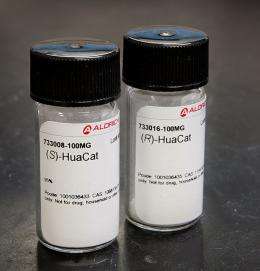New organic catalyst should enhance drug research and development

A new "organocatalyst" developed at Oregon State University is now available for commercial use. Produced by an Albany, Ore., pharmaceutical company, it should make new drug development around the world less costly, more efficient and more environmentally friendly.
This catalyst, named "Hua Cat," is also one of the first products to reach the marketplace as a result of support from the University Venture Development Fund, an initiative finalized in 2007 by the Oregon Legislature to create jobs and aid business by bringing university-based discoveries to commercial use.
The product itself is a new and important part of the field of organocatalysis, which experts believe offers a better and more affordable avenue for research and commercial production of new drugs, while eliminating the need for toxic heavy metals often used in the past.
"Organocatalysis is a very young science, but we believe it's about ready to take off and provide improved methods for drug research and development," said Rich Carter, an OSU professor of chemistry, a national leader in this field and co-inventor of the new catalyst along with Hua Yang, an OSU postdoctoral research associate.
"These types of catalysts can be used in the development of almost any type of drug, whether they are for treating cancer, heart disease, infectious disease or other health problems," Carter said. "At the same time, OSU students are now gaining an edge in the new era of environmentally-friendly medicinal chemistry."
The catalyst was developed in close collaboration and with the support of Synthetech, an Albany, Ore., contract manufacturer of pharmaceutical products, and a wholly-owned subsidiary of W.R. Grace, Inc. OSU patented the technology and is licensing its use to private industry.
"Hua Cat is very user-friendly for drug development – simple but effective," said Michael Standen, director of technology for Synthetech. "It's this type of inventive, creative technology, and our close relationship with the university that is helping us to keep jobs and production here in Oregon and the U.S.
"That's very exciting," Standen said. "And we really believe that organocatalysis is a field that's about ready to blossom, to become an important part of a $350 billion drug development industry."
Catalysts are chemical compounds that help facilitate other chemical reactions without themselves being consumed – in industrial production, they can be used over and over. Most medicinal drugs are based on what are called chiral molecules, which are like two mirror images that fit together like a lock and key. A catalyst is often used to induce molecules to become chiral and give them the ability to treat disease.
Existing approaches to create these chiral compounds, however, often use toxic metals, which can also be expensive and create waste disposal issues. By contrast, an "organocatalyst" can not only work better and cost less, but eliminate the environmental concerns.
This particular catalyst was invented by OSU scientists because nothing else that existed was working for one of the compounds they were trying to develop. It was only after creating it that they realized it had a huge range of possible applications in the broader field of drug development.
The Hua Cat catalyst is derived from innocuous compounds such as amino acids, soaps and cleaning solvents. It has a solubility that's 10 times higher than related compounds now being used for drug development. That solubility and its unique chemical reactivity should make it a very important product to facilitate new drug discoveries, OSU researchers say.
Continuing research is already developing variants on the Hua Cat catalyst that should have other useful applications, they said.
Provided by Oregon State University
















